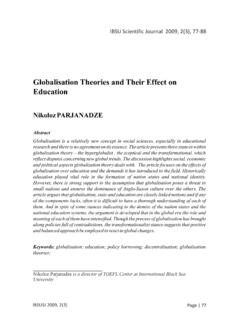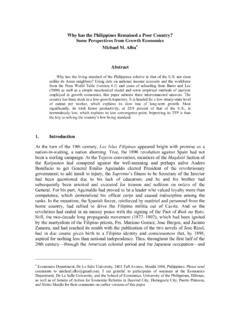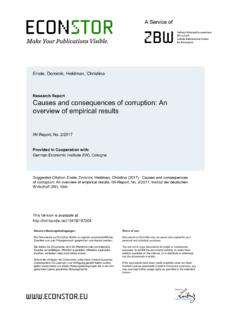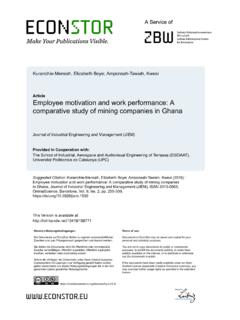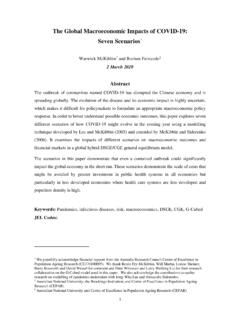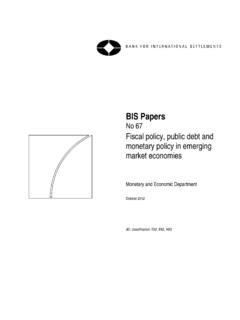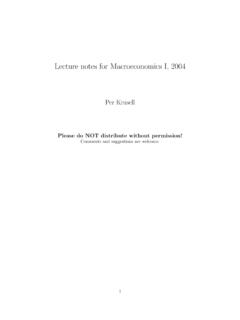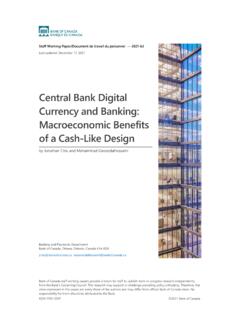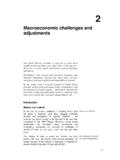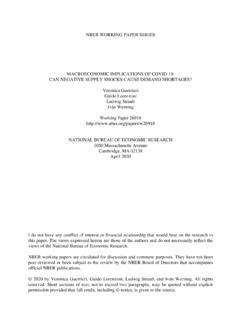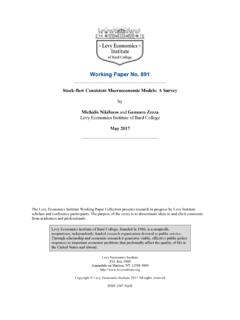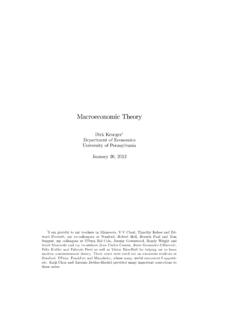Transcription of Philippine Macroeconomic Issues And Their Causes
1 Philippine Macroeconomic Issues And Their Causes by Gerardo P. Sicat Table of Contents I. Introduction: Macroeconomic and structural problems .. 1 II. The Rate of Economic Growth and 2 III. Widening disparity between GDP and 6 IV. Composition of aggregate output and demand .. 7 Aggregate demand .. 7 Aggregate supply of 7 V. Saving-investment gap, or Why the low investment rate?.. 9 VI. Fiscal deficit: taxes, expenditure and public debt .. 11 Tax revenues .. 12 Tax Public expenditure 15 Public enterprises and 16 Financing the public debt .. 17 VII. Trade, balance of payments, and external 19 Exports and industrial performance .. 20 Trade and payments balance .. 22 OFW remittances .. 23 VIII. Concluding remarks: direction without drift?
2 24 Statistical 26 I. Introduction: Macroeconomic and structural problems This paper reviews some Macroeconomic Issues relating to the current Philippine economy. To provide a proper understanding of these Issues , Their link will be associated with Their structural underpinnings. Persistent Macroeconomic problems often require a policy adjustment. Inevitably, the assessment of the problems boils down to an understanding of what gets done, what gets delayed or what is not possible to do under the circumstances. A further device in presenting the Issues is through a comparison with the experience of other East Asian and high growth countries, which includes some ASEAN countries. The review follows this sequence. First, the recent growth performance of the economy is discussed. Then, the compositions of aggregate demand and of aggregate supply are described, emphasizing the reasons for the observed changes and trends.
3 Next, the economy s saving and investment Issues are highlighted, paying notice to the large Professor Emeritus of Economics, University of the Philippines. This paper is a revised version of the author s presentation at a Conference on the Philippines with the theme Whither the Philippines in the 21st Century, July 13-14, 2006, at the Institute of Southeast Asian Studies, Singapore. The statistics used throughout the study are derived from Philippine government sources. They may be reviewed from the Philippine Economic Indicators in the Bangko Sentral web page, The international data comparison are taken and calculated from the Asian Development Bank s Key Indicators, an annual publication. G. Sicat, Philippine Macroeconomic Issues Page 2 of 30 Last printed 11/3/2006 2:27:00 PM gap between saving and investment.
4 After that, the spotlight moves to the fiscal front that is a major contributor to the country s low saving rate. The fiscal sector is discussed in terms of dealing with deficit reduction and managing the public debt. Finally, the review expounds on the economy s external trade and payments position. Current problems and new opportunities are discussed in the context of globalization and the country s open stance. A major theme that arises from this discussion is that the potentials for development in the Philippines are not fully exploited at home. This underperformance contributes acutely to the slow conquest of poverty. A relative measure of this underperformance can be derived from the immense turnaround of economic prospects in 2006 just as soon as the government was able to deal with a reform of the fiscal front.
5 A result of these measures led to higher tax revenues being earned, thereby saving a deteriorating fiscal problem. A lot of other benefits affecting Macroeconomic fundamentals were likewise experienced, changing the dynamics of political and economic discourse. II. The Rate of Economic Growth and Productivity Recent growth rates in the Philippine economy have ranged from 3 percent per year to percent the average growth rate of this from 1999 to 2005 is percent. This is the growth of the GNP, a measure of total national income, not of GDP, or a measure of total output produced in the country. The annual GDP growth rate during the same period is lower, percent. (The significance of this discrepancy is explained in detail later, below.) Philippine economic growth has been on the modest side compared to that of high growth East Asian economies.
6 During Their rate of sustained growth in recent decades, these latter countries have achieved annual growth rates of real output ranging from 7 percent to 10 percent per annum of real output and income growth during Their periods of sustained growth. The Philippines is literally surrounded by these countries in the north, Japan (the earliest of the achievers during the 1950s to the 1970s), South Korea, Taiwan, Hong Kong, Singapore and Malaysia. Today, China is repeating the early economic miracles of these countries but on a larger scale. Indonesia had done very well four four decades but it performance was reversed by a lost momentum after recent political and economic crises. Philippine economic performance has been characterized by recurrence of booms and busts that are sharp around average rate of economic growth.
7 As soon as Macroeconomic fundamentals had gathered momentum to reach a particular environment of encouraging growth, imbalances come back in the form of balance of payments and difficulties on the fiscal front. In part, this problem of recurring imbalances is due to lack of timely action related to the required economic remedies. Such policy actions are often painful and therefore difficult to push in the political front. The remedies are often in the form of adjusting Macroeconomic policies such as dealing with tax reform and expenditure cuts. But often the problems that jolt the economic performance arises from some structural inflexibility that makes the economy very sensitive to political jolts of a G. Sicat, Philippine Macroeconomic Issues Page 3 of 30 Last printed 11/3/2006 2:27:00 PM domestic origin or from external economic events.
8 Such weakness in flexibility helps to disturb investment confidence. There is another feature that characterizes the Philippine growth experience with that of the immediate neighbors. Population growth in the Philippines continues to be high at around 2 percent per year and has hardly changed much in rate of growth in recent years. This means that per capita growth of income and of output is lower because the high population growth absorbs much of the growth of the economy if only to maintain consumption per capita. In comparison, the East Asian high performers have experienced a halving of Their rates of population growth from highs of close to 2 per cent per year during the 1960s toward 1 percent per year by this decade. The rate of economic growth of output and of productivity in an economy depends on the technical relations with the rate of growth of the inputs of capital, labor, and other economic resources that enter the production process.
9 A productive and efficient economy displays a high rate of economic growth that helps to eradicate a high level of unemployment. In these relations, the quality of the inputs (amount of knowledge, skills, and learning by experience of the labor force) builds up. It is not surprising that rising incomes and the savings derived from falling birth rates induce a higher investment in education, nutrition, and family welfare. They improve the efficiency of labor even as the economy and as the rise of inputs help to accelerate the growth of output. Aggregative studies of growth and productivity have consistently explained that Philippine economic growth is due to the growth in the employment of capital and of labor But total productivity growth has been inconsistent and in fact indicates that during some episodic periods, the growth of productivity had been nil or negative while the growth of capital inputs and of labor inputs have been positive.
10 The rate of capital accumulation in the economy has been in general adequate during the years of development. However, even though at the same time such a growth of investment has led to the employment of labor, the total growth of output and productivity has not been adequate to generate a high level of employment and productivity growth. These studies provide statistical evidence of what was happening in the aggregate. But to understand why this had taken place would require an analysis of the manner in which economic policy evolved in the goods and factor markets. In terms of the goods market, the industries that were promoted for a long time were mainly dependent on protection and high tariffs and government support, with many of them unable to become competitive as the economy was opened toward greater competition with international trade.
